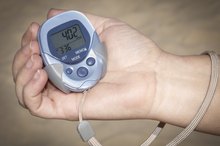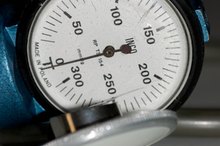How to Measure Heart Rate on a Telemetry Strip
By definition, telemetry is the technology and science of measuring and transmitting data from a remote source (using wires or radio waves) to a receiving station. In a medical setting, this is often performed using an electrocardiogram, or EKG. Electrocardiograms are a painless testing method characterized by the patient being connects to electrodes which, in turn, measure the patient’s heart rhythm and display it on a printed read out. From the telemetry strip that is printed, medical professionals can determine whether or not the heart rhythm is normal and measure the patient’s heart rate.
Calculating Heart Rate from an EKG
Remove a strip from the EKG. You’ll note that the rhythm is printed on graph paper which generally measures time using a scale of 25 millimeters representing 1 second. There will also be marks (called hash marks) at the bottom or top of the telemetry strip which will indicate intervals of either 1 second or 3 seconds.
How to Count the Boxes on the EKG Paper to Determine Rate
Learn More
Use the Six Second Count method. According to NurseCom.com, this is the most common (and simple) method to determine heart rate. Multiply the number of QRS complexes found over six seconds by 10. This will give you the number of QRS complexes in 60 seconds, or 1 minute. This is the patient’s heart rate. For example, if there are 8 QRS complexes in a 6-second period, multiply it by 10 and you have a heart rate of 80.
Use the Triplicate Method. This method can be used only with a regular rhythm. Consider that each large square on the telemetry strip is equal to 5 millimeters, or one-fifth of 1 second. Start by locating an R wave (the spikes in the readout) falling on a thick vertical line. Now find the next R wave and the R waves following that. Start with a heart rate of 300 and divide it by the number of large telemetry squares between the R waves. If each one occurs with only one large square between them, then the heart rate is 300. If there are 4 large squares, the heart rate is 75.
How to Read an Abnormal EKG
Learn More
Use the Caliper Method. This yields the most exact calculation by counting the millimeters between R to R intervals using a tool called a caliper. If you print the telemetry strip for a full minute, you will have a total of 1500 millimeters (25 millimeters per second multiplied by 60). Now divide 1500 by the amount of millimeters in the R to R interval. The resulting number is the heart rate. For example, if you measure 20 millimeters in the R to R interval, you would divide 1500 by 20. This equals a heart rate of 75.
Tips
Heart rate is defined as the number of QRS complexes that occur in 1 minute. QRS complexes measure ventricular activity in the heart known as ventricular depolarization.
You can use whichever method works best for you if the patient has a regular rhythm.
Warnings
If the patient has an irregular rhythm, the most accurate method of measuring heart rate is the 6 Second Method.
Related Articles
References
- MedCEU.com: Telemetry Certification
- NurseCom.com: ECG Primer
- American Heritage Dictionary: Telemetry
Writer Bio
Caryn Anderson combines extensive behind-the-scenes writing experience with her passion for all things food, fashion, garden and travel. Bitten by the travel bug at the age of 15 after a trip to Europe, Anderson fostered her love of style and fashion while living in New York City and earning her degree at New York University.








